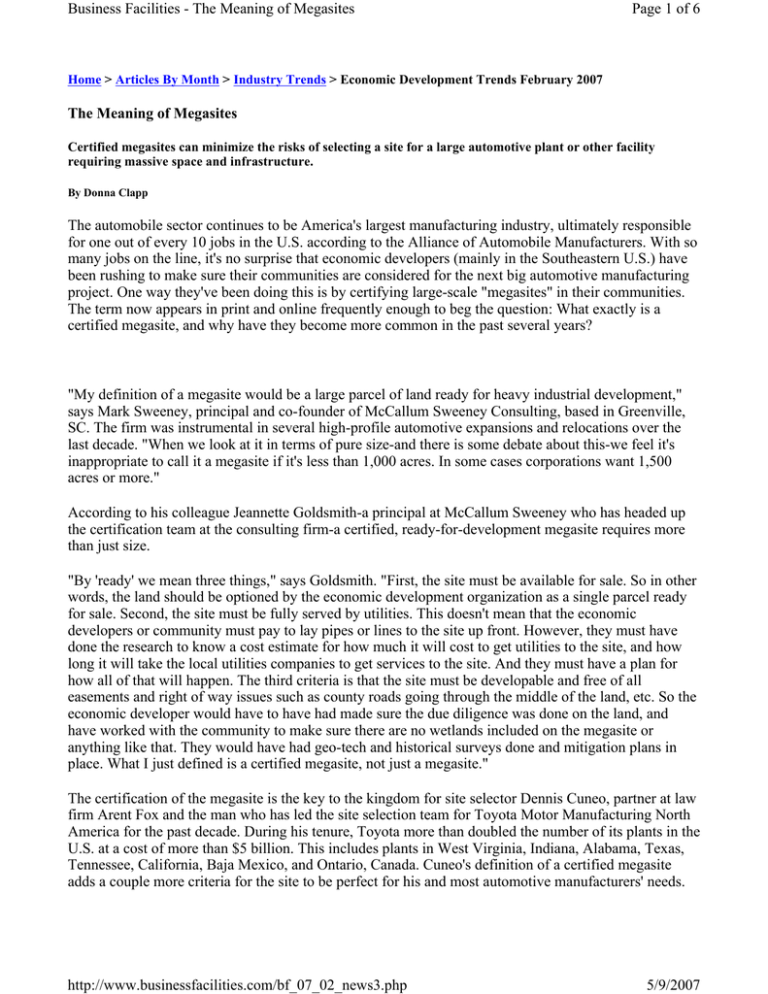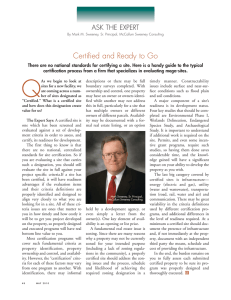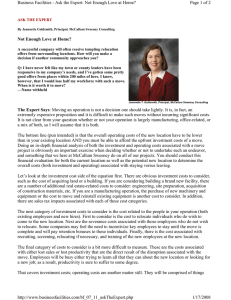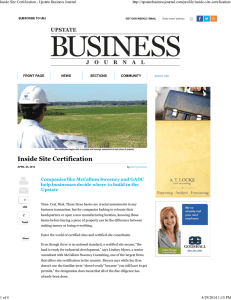The Meaning of Megasites Page 1 of 6
advertisement

Business Facilities - The Meaning of Megasites Page 1 of 6 Home > Articles By Month > Industry Trends > Economic Development Trends February 2007 The Meaning of Megasites Certified megasites can minimize the risks of selecting a site for a large automotive plant or other facility requiring massive space and infrastructure. By Donna Clapp The automobile sector continues to be America's largest manufacturing industry, ultimately responsible for one out of every 10 jobs in the U.S. according to the Alliance of Automobile Manufacturers. With so many jobs on the line, it's no surprise that economic developers (mainly in the Southeastern U.S.) have been rushing to make sure their communities are considered for the next big automotive manufacturing project. One way they've been doing this is by certifying large-scale "megasites" in their communities. The term now appears in print and online frequently enough to beg the question: What exactly is a certified megasite, and why have they become more common in the past several years? "My definition of a megasite would be a large parcel of land ready for heavy industrial development," says Mark Sweeney, principal and co-founder of McCallum Sweeney Consulting, based in Greenville, SC. The firm was instrumental in several high-profile automotive expansions and relocations over the last decade. "When we look at it in terms of pure size-and there is some debate about this-we feel it's inappropriate to call it a megasite if it's less than 1,000 acres. In some cases corporations want 1,500 acres or more." According to his colleague Jeannette Goldsmith-a principal at McCallum Sweeney who has headed up the certification team at the consulting firm-a certified, ready-for-development megasite requires more than just size. "By 'ready' we mean three things," says Goldsmith. "First, the site must be available for sale. So in other words, the land should be optioned by the economic development organization as a single parcel ready for sale. Second, the site must be fully served by utilities. This doesn't mean that the economic developers or community must pay to lay pipes or lines to the site up front. However, they must have done the research to know a cost estimate for how much it will cost to get utilities to the site, and how long it will take the local utilities companies to get services to the site. And they must have a plan for how all of that will happen. The third criteria is that the site must be developable and free of all easements and right of way issues such as county roads going through the middle of the land, etc. So the economic developer would have to have had made sure the due diligence was done on the land, and have worked with the community to make sure there are no wetlands included on the megasite or anything like that. They would have had geo-tech and historical surveys done and mitigation plans in place. What I just defined is a certified megasite, not just a megasite." The certification of the megasite is the key to the kingdom for site selector Dennis Cuneo, partner at law firm Arent Fox and the man who has led the site selection team for Toyota Motor Manufacturing North America for the past decade. During his tenure, Toyota more than doubled the number of its plants in the U.S. at a cost of more than $5 billion. This includes plants in West Virginia, Indiana, Alabama, Texas, Tennessee, California, Baja Mexico, and Ontario, Canada. Cuneo's definition of a certified megasite adds a couple more criteria for the site to be perfect for his and most automotive manufacturers' needs. http://www.businessfacilities.com/bf_07_02_news3.php 5/9/2007 Business Facilities - The Meaning of Megasites Page 2 of 6 "Toyota looks for around a 1,500-acre range in terms of size for a new plant," says Cuneo. "The site must have access to dual rail [two providers of rail service] and easy highway access, as well as sufficient utilities such as water, sewer, natural gas, and high-powered electricity. The reasons for the size of the site can vary, but we typically want space for buffer zones between us and the community space for such things as test tracks and in some cases space to have on-site suppliers. Often we want the flexibility to expand the plant at that site as well." While the criteria that automotive companies look for in a site are fairly similar from corporation to corporation, there is no standards body for certification of a megasite. Several site selection consultants certify sites to their own specifications, as do some economic development entities. "There is no standard definition of a megasite or a certified megasite," says consultant Sweeney. "McCallum Sweeney is not 'the standard,' because there is no national standard. There are other consulting agencies that certify sites, and some economic development organizations certify their own sites. But they set their own standards, which we think is not as reliable. Certification is not a consultantdriven prospect. Certification is end-user driven. As location consultants, we've found there is more and more pressure from our clients when they are choosing a location for a project. The clients don't want to take a long time to choose a location and once it's chosen, they don't want to take a long time to get started building. That's where the call for certification started to become necessary. "Certified sites, whether they're megasites or smaller sites, let clients get started building right away, which is why so many developers have started to market their locations as certified sites. It's also important to know that McCallum Sweeney didn't originally put our name on our certification processour client [Tennessee Valley Authority] did." The History Certified megasites have really only been around for a short period of time. Cuneo and Toyota, along with the Tennessee Valley Authority (TVA) were the originators of the idea of certifying large tracks of land for automotive project. "I had a conversation with Bill Baxter from TVA when we were looking to choose a location back in about 2001," explains Cuneo. "During that particular site search, what struck me most was that most economic developers didn't know what they needed to attract an automotive project to their community. We talked about how much easier and faster it would be to choose a location if communities had an inventory of sites that fulfilled the criteria an automotive plant was looking for. At that time I told him what we would need to know about a site to consider it." It turns out that McCallum Sweeney had recognized the need for certifying megasites about a year before Cuneo had that conversation with TVA. "When we were doing the site location project for Nissan in 2000, we really started to recognize that there was a need for economic developers to have these larger parcels of land ready to go in the same way they did for smaller sites," says Sweeney. "Nissan did not want to take a long time to get started once they chose a site. Because of that, there were a lot of locations that did not make the short list because their larger parcels of land had not had the due diligence necessary to let our client know how quickly they would be able to get started if they chose that site. That's when we started to think about what it would take to certify large parcels of land to have them ready for large projects." TVA was the first economic development entity to start looking at having its megasites certified. While http://www.businessfacilities.com/bf_07_02_news3.php 5/9/2007 Business Facilities - The Meaning of Megasites Page 3 of 6 (From top to bottom) Commerce Park in Montgomery County, TN; The PUL Alliance Wellspring Project in Tupelo, MS; West Tennessee Auto Park in Crockett County, TN; The Interstate 24 Megasite in Hopkinsville, KY certified sites programs have been around for a decade, most of these sites were smaller parcels of landtoo small for an automotive project. "Why we got into certifying megasites to begin with was because back in August of 2002, we beefed up our recruitment efforts," says John Bradley, Vice President of Economic Development for TVA. "We did a target industry analysis and we targeted automotive because we had a history of automotive already and we had heard that there were going to be more projects coming to the Southeast. My colleague Bill Adams and I spoke to three automotive firms about what due diligence they needed to be done, so we would know what an automotive project needed. Then we put out an RFP to about 200 site consultants. When we narrowed it down, we hired McCallum Sweeney, because when they laid out their criteria for certification of a megasite, it matched nearly exactly what the automotive companies had asked for. Then we asked the communities in the TVA territory if they wanted to try for certification, and we had about 25 communities tell us they wanted to go for it. "I think the process is more than just a certification," continues Bradley. "It's one of the best processes for a community to go through, because it means the communities [end up training] economic developers [to] really know what corporations need." http://www.businessfacilities.com/bf_07_02_news3.php 5/9/2007 Business Facilities - The Meaning of Megasites Page 4 of 6 What Certification Provides The certification process is a rigorous round of due diligence, and is certainly not inexpensive for communities that choose to take it on. So, why would an economic developer choose to go through the process? TVA's Bradley feels it's well worth all the effort. "For the communities who go through the certification process, it is a win-win situation even if they don't get certified for automotive because McCallum Sweeney tells them what industry would work well with the sites they have available," says Bradley. "It's a strenuous process for the community, but for those that did get certified as a megasite, there's a lot of potential for those sites. In fact, the very first megasite we certified was sold within a month of certification to a steel company who supplies the automotive industry. The key here is that it is truly a preparedness program and any time spent on the front end is time saved by the corporation once they've chosen the site. It provides a six-to nine-month advantage for us over the competition, and that goes for the corporation that chooses the site as well. They get a six- to nine-month advantage over their competition by being able to start Aerial map of Cecil Field in Jacksonville, FL building right away. Companies are going to come to expect this type of preparedness, and we were the first ones to do it-and successfully too. I mean selling the first site within a month-you don't get much more successful than that, and the due diligence was done so well on that site that the company had bulldozers in there within just a couple of weeks of choosing the site." Cuneo says that for a corporate site selector who chooses a certified megasite, it's a win-win situation as well. "There is almost always a huge time constraint on us when we are choosing to build a new facility, so when I've been told that we need to be up and running within three years, it means not only that we must choose a site quickly, but the site must be ready to build on," says Cuneo. "We don't have time to do a lot of remediation. So it's a great advantage when communities certify a site and put it out there on the Web. Certification of a megasite is an advantage for us as site selectors, but it's also an advantage for the community. The process allows for the community to find out how difficult it is to assemble a site large enough and with the right criteria for an automotive corporation to consider it. It also lets the community choose whether they're prepared to invest in the site to provide the corporation with what it will need there. There is no perfect site, but when a community looks to certify a site they learn up front, before spending any money, what is needed for an automotive assembly plant to choose to build there." What it comes down to is that not only is "location, location, location" important when choosing a site (especially for such huge projects), but that time is also of the essence. "While choosing a certified megasite for a new plant is not a substitute for doing due diligence on the site, it lets me know pretty much what I can expect," says Cuneo. "I know the parameters up front. I estimate that choosing a certified megasite shaves six to 12 months off the selection and building http://www.businessfacilities.com/bf_07_02_news3.php 5/9/2007 Business Facilities - The Meaning of Megasites Page 5 of 6 process. It gives me a degree of certainty that I can start production on time. And for the communities, the certification process is a plus because it can put their location on the radar screen for site selectors when it may not even have been thought of. "Certification takes a site that wouldn't even be looked at sometimes and it puts it at least in the running for the first list of sites to be looked at. The certification process allows for us to move quickly and to remain anonymous at the beginning stages of the site search, especially if a community puts their certified sites on the Web. "This is really important," continues Cuneo, "because when we have to start actually contacting economic developers about what we're looking for, that's when expectations rise and rumors get started and the cost of tracks of land goes up. So if we can do the preliminary search without all of that happening, it's better for everyone involved. For example, if we send people out to do soil boring, rumors get started, but if McCallum Sweeney goes to do it to certify the site then speculation is not likely to happen." Current Examples of Certified Megasites Here's a short list of certified (by McCallum Sweeney or otherwise) megasites to get your site selection process started: z z Cecil Field, Jacksonville, FL. This 17,000-acre former Navy base closed in the late 1990s and has been certified by McCallum Sweeney. Jerry Mallot, executive vice president of Cornerstone Economic Development at the Jacksonville Regional Chamber of Commerce, explains its selling points: "It's a huge area that includes an airstrip on the Southern portion of the site and nearly 10,000 acres of undeveloped land on the northern portion. One of the most attractive things about this site is that it's protected on all sides. The entire western edge is preservation lands, so there are no neighbors and no community problems. The eastern side is where the Interstate 95 interchange and the start of the Jacksonville outer beltway was built. The I-10 butts up to the northern end of the site, and the JEA Utility substation is on the southern end. For the northern portion of the site, which is about 1,500 acres, we are targeting an automotive project; for the southern portion we've got an additional 1,000 acres [for which] we're targeting aviation projects since it's got a runway on it already. A project that chooses this site could actually start developing the site within 90 to 120 days because everything is already complete on it." Franklin Farm megasite in Holly Ridge, LA. The site has 4,500 acres adjacent to it, and is located on Interstate 20 about midway between Nissan's plant in Jackson, MS and GM's assembly plant in Shreveport, LA. The state has also recently committed $5.8 million to build the Greater Ouachita Port in Ouachita, LA. The port site, which is located less than 30 miles away from Holly Ridge, will complement the megasite. TVA megasites certified by McCallum Sweeney (which, among other things, have soil boring reports and a Phase I environmental report completed) include: z z Commerce Park, Central Tennessee's Megasite, in Clarksville-Montgomery County, TN. The site is 1,187 acres, and all utilities are less than one mile away. The property is in the direct vicinity of existing industrial area, and has a single property owner. Distance to a major interstate highway is four miles and rail access is feasible. I-40 Advantage Auto Park in Haywood County, TN. The park is adjacent to Interstate 40 and US Highway 70/79, the park has rail access via CSX Mainline. It's within 45 minutes of the http://www.businessfacilities.com/bf_07_02_news3.php 5/9/2007 Business Facilities - The Meaning of Megasites z z z z z Page 6 of 6 Memphis International Airport, home to FedEx World Headquarters, and is 50 miles from the Port of Memphis. The site is within 60 minutes of a population of over 1.7 million people (30 minutes east of Memphis, TN). Preliminary environmental and geotechnical work have been completed, and the property has all utilities. West Tennessee Auto Park in Crockett County, TN. The park is on 1,600 acres; all utilities, including gas, electric, sewer, and water are in place. It is adjacent to US Highway 412 and has rail access supplied by CSX Mainline. The site is 15 miles from a major commercial airport, and is 80 miles from the Port of Memphis. Industrial Park South in Chattanooga, TN. This site consists of 1,600 developable acres surrounded by a 2,800-acre buffer to the east and a 128-acre buffer to the west. When complete, it will include 3,000 developable acres while retaining both buffers. The property has all utilities. It is adjacent I-75 (dedicated interchange under construction) and has dual rail access supplied by CSX and Norfolk Southern; 80% of the U.S. population is within a two-day drive. The city and county own the property. Lowndes County Crossroads Megasite, near Columbus, MS. This 1800-acre property has all utilities, including gas, electric, sewer, and water. It is two miles to Highway 82 and has rail access supplied by KCSR. The site is adjacent to the Golden Triangle Regional Airport and eight miles to the Columbus Port, with direct access to the Port of Mobile. PUL Alliance-Wellspring Project in Tupelo, MS. Adjacent to I-22 (U.S. Highway 78), this 1,200-acre site has available rail transportation, and is 60 minutes from Memphis International Airport. An existing interchange is situated near the property's midpoint, and another interchange is located four miles southeast. The Burlington Northern Santa Fe Railroad has agreed on the alignment and extension of a proposed spur off their mainline, which is situated northeast of the site. Also, as a second option, the Mississippi Tennessee Railroad has agreed to extend rail service to the site. The property has capability for all utilities. Hopkinsville-Christian County Interstate 24 Megasite in Kentucky is a massive 2,100-acre site featuring immediate access to I-24 and rail supplied by CSX railroad. Looking for information on locations, click here FacilityCity • Business Facilities • BFLiveXchange • Today's Facility Manager • The TFM Show® • TFM Forum • Group C ©2007-2008 Group C Communications, Inc.. All Rights Reserved. 44 Apple Street, Suite #3, Tinton Falls, NJ 07724 Tel:732.842.7433 • Fax:732.758.6634 Contact Us • Terms Of Use • Privacy Policy http://www.businessfacilities.com/bf_07_02_news3.php 5/9/2007


